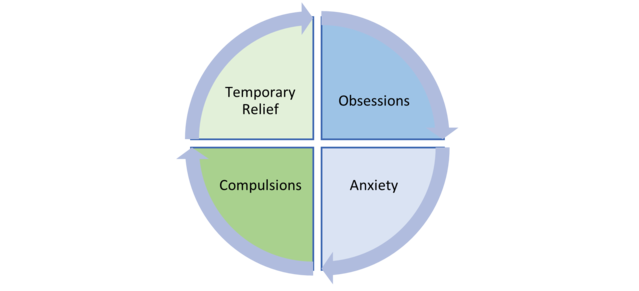OCD
What Is Perinatal OCD?
The most misunderstood disorder during pregnancy and postpartum.
Posted October 13, 2022 Reviewed by Jessica Schrader
Key points
- Obsessive-compulsive disorder during pregnancy and postpartum, or perinatal OCD, affects 7 to 11 percent of new moms.
- A primary indicator for P-OCD is a recurring cycle of obsessions and compulsions.
- There are effective medication and non-medication approaches for the treatment of P-OCD.
While most people have at least heard of postpartum depression, there is actually a collection of mental health disorders that can occur during pregnancy and after childbirth. Upwards of 1 in 5 women will suffer from a mental health condition during pregnancy and/or the first year postpartum, also known as the perinatal period. Perinatal obsessive-compulsive disorder (P-OCD) is one of the anxiety disorders that affects about 7 percent to 11 percent percent of women during this period. Typical postpartum onset occurs one week to three months after childbirth with peak prevalence at about eight weeks postpartum.
As Karen Kleinman, an international maternal mental health expert, has stated, “good moms have scary thoughts.” Thoughts, such as, “What if I drop the baby?” or images of doing so are alarming and generally pop up out of nowhere. While Karen Kleinman reports that over 90 percent of new mothers will have scary, intrusive thoughts about their baby and themselves at some point, this does not mean almost every new mom has P-OCD.

Signs and Symptoms
Because it is common for expecting and new parents to have unwanted thoughts and anxious feelings it can sometimes be difficult to accurately detect P-OCD from someone who is adjusting to this new phase of life. However, a difference is that the intrusive thoughts and anxiety of P-OCD are recurring (not temporary), they cause emotional distress, and get in the way of daily functioning. It is also important to distinguish P-OCD from other types of perinatal mood and anxiety disorders that occur in about 20 percent of expecting and new parents, with the most common being anxiety and depression.
The primary indicator for P-OCD is a recurring cycle of obsessions and compulsions. Obsessions are not simply excessive worrying about new parenthood or an occasional distressing thought. Instead, obsessions are persistent, intrusive thoughts and images that result in significant distress. The most common perinatal obsession is harm to the baby. These anxiety-inducing obsessions trigger compulsions.
Compulsions are the behaviors or mental acts a parent feels driven to engage in to prevent or reduce obsessions and their accompanying distress. An example of compulsive behavior is excessively checking on the baby's breathing to ensure they are still alive. Alternatively, an example of a mental act is excessively praying for the baby’s well-being. Both types of compulsions might momentarily prevent or reduce intrusive thoughts and distress; however, the new parent is stuck in an anxiety-driven loop.

An important point to reiterate for P-OCD is that obsessions cause significant distress. This is also known as ego-dystonic thoughts. It is distressing to the parent because they recognize the unwanted thought as being alarming and inconsistent with their values as a parent. Ego-dystonic thoughts are different from the delusions in postpartum psychosis, an over-publicized disorder in the media that only affects 1-2 in 1,000 births. A parent struggling with P-OCD does not want to harm their baby and the thoughts are disturbing to them, not delusional. As such, they are at low risk of acting on them.
Potential Causes
Women in the perinatal period are at 1.5 to 2 times greater risk for OCD onset than the public. While the transition to new parenthood is a risk factor in itself for the development of P-OCD, several additional factors put a new parent at greater risk for the onset of P-OCD. These include:
- Personal and family history of anxiety disorders, including OCD.
- Sensitivity to hormone changes.
- Preterm delivery and cesarean (C-section) delivery.
- Prior pregnancy losses.
- Prior traumas and stressors.
If you’ve experienced any or all these risk factors, you are not destined to develop P-OCD. Remember, about 7 percent to 11 percent of women develop OCD during pregnancy and postpartum. If you have concerns, talk with your healthcare provider about your symptoms.
How People Can Cope
The cycle of obsessions and compulsions from P-OCD can be particularly painful for new parents because it can lead to a fear of being alone with their baby and make it difficult for parents to bond and care for them. Because the symptoms of P-OCD can be so upsetting and have far-reaching impacts on the whole family, below are a few suggestions for what you can do:
- Talk to your health provider if you experience any symptoms of P-OCD. There are effective treatment options for therapy and safe medications, even if you are pregnant or breastfeeding.
- P-OCD is treatable with professional help. Locate a therapist specifically trained in perinatal mental health indicated with certification (PMH-C) through Postpartum Support International. You can also find a provider who specializes in mental health therapies such as cognitive-behavioral therapy (CBT) or exposure and response prevention (ERP), shown to be effective in treating P-OCD.
- Ask for and accept support from trusted others in your network so you can engage in self-care, including getting adequate sleep, proper nutrition, and physical activities appropriate for your stage of pregnancy or postpartum healing. Self-care does not mean that you are putting yourself before your baby. Self-care means you are taking care of yourself so you can also take care of your baby.
- Remember, thoughts ≠ actions! Having distressing thoughts does not mean you will act on them.
To find a therapist, please visit the Psychology Today Therapy Directory.




